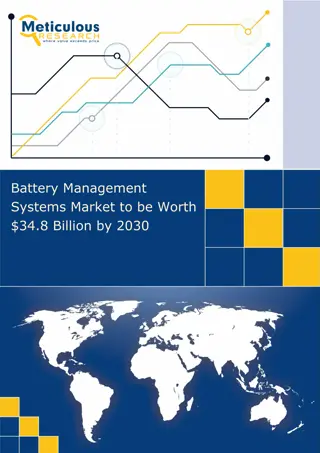Assessment of War Damage Under EVS: Overview and Best Practices
Explore the importance of assessing war damage to properties and businesses, including the costs of restoration and the need for evidence-based claims assessment. Learn from past experiences, such as the Kuwait precedent, to ensure a professional and trustworthy valuation process.
- War damage assessment
- Property valuation
- Costs of restoration
- Evidence-based claims
- Trustworthy process
Download Presentation

Please find below an Image/Link to download the presentation.
The content on the website is provided AS IS for your information and personal use only. It may not be sold, licensed, or shared on other websites without obtaining consent from the author. Download presentation by click this link. If you encounter any issues during the download, it is possible that the publisher has removed the file from their server.
E N D
Presentation Transcript
Assessment of War Damage Under EVS Jeremy Moody Vice Chairman, EVSB TEGoVA Warsaw Valuation Conference 17thJune 2023
. But the Valuer must be Professional
Overview The need to assess separately Damage and loss caused by the war to property, business and other matters caused Costs of restoration (potentially Building Back Better) The need to evidence and assess claims Finding the methodologies and process TEGOVA approached by Ukraine EVSB reviewed issues with SPFU Issued guidance, now broadened for war generally Learn from precedent with experience of Kuwait How to do all this well, ensuring trust?
Compensation for Loss The 1927 Chorzow decision The essential principle of an illegal act .. is that reparation must as far as possible .. re-establish the situation that would, in all probability, have existed if that act had not been committed. Restoration not improvement Followed by the UN Compensation Commission for Kuwait after 1990 invasion Adopted by the International Law Commission Basis of action for reparations claims
Basis Loss compared to the day before hostilities Need the best evidence of values then and now Need good evidence to prove the loss As war damage Contemporary records, photographs, Technology - drones, LiDAR, satellite, modelling Objective independent evidence where possible Delay weakens evidence, risks confusion, The challenge of inspection War zones - land mines, munitions, contamination Easier in other areas but Verifying other losses machinery, money,
Approach to Assessment Date for assessing losses start of the war Before 24thFebruary 2022 for current war Before 20thFebruary 2014 for occupied areas For claimant to make their case Allows for the variety of cases Keeping contemporary evidence Valuation assumption as to title Valuation assumption as to pre-war condition Standard valuation methodologies - EVS Business - use most recent data, accounts etc Comply and use EVS as recognised standards
Heads of Claim Property taken or affected Loss of market value at the date Total write-off? Cost of remediation? Equivalent reinstatement Business destruction and disruption, such as: Repairs from buildings to restoring soils/ drainage Values of plant, equipment, inventories Frustrated contracts Extra storage costs The valuation and other professional fees State procedure to assess the claims made Reviewing evidence given
Issues for Valuers? Clarity of Instruction - Can the property or business be defined? Who is the client? Evidence - Is there good/any market evidence? How reliable might damage assessments be? How often will there just be total loss? Conflicts of Interest Direct being independent of the claimant General to show a Ukrainian valuation is objective All open to later challenge The key role of valuation standards Supporting professional care to give trust
Example A Farm Crops burnt in the field; livestock killed or lost Stored crops and produce, feed, other goods Buildings, machinery, irrigation, reservoirs, etc Land Soil structure destroyed cratered, fought over Lost productivity - for how many years? Landmines and unexploded munitions Contamination phosphor, chemical spills Flooding soil lost, water supply lost, contamination How far might the costs of restoring the land exceed its value?
Process and Realities What system can handle all this? How many claims? Will all have merit? The balance between speed and fairness Keeping it trusted and transparent Can claims be grouped? Can they be managed by type of value? Where is it right to use standard values? Initial assessment (triage)? What losses are too remote? Alternative dispute resolution; before the courts
Where Might This Go? Assessment for possible reparations Kuwaiti claims were repaid out of Iraq s oil revenues Claims on sanctioned/frozen funds? Challenge of scale Number and variety of cases Displacement of people Conditions on the ground Kuwait took 20 years plus with many claims BUT it does give a baseline assessment As part of planning for after the war To support requests for international aid
Restoration Ukraine will want to Build Back Better The chance to build a new Ukraine Modern standards Green restoration: energy efficiency, environment, etc Scale of a very large task - timescale Principles Where will people want to live and work? Planning and looking ahead Needing international support BUT risk of rising costs of materials, contractors, etc. How long might this take?























